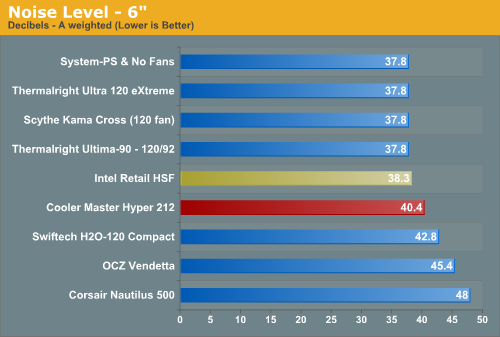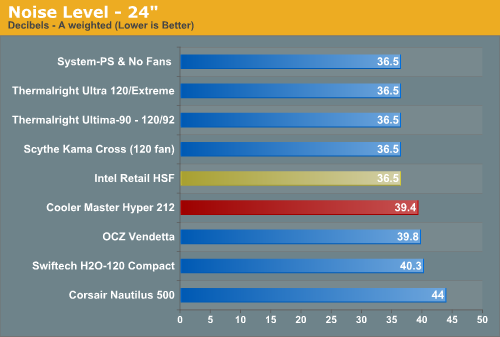Cooler Master Hyper 212: Looking for a Winner
by Wesley Fink on October 31, 2007 2:00 AM EST- Posted in
- Cases/Cooling/PSUs
Noise
For many enthusiasts upgrading cooling the goal is maximum stable overclock, and they will live with the inconvenience of a louder system. For other users silence is the most important factor, and these users will forgo maximum overclocking if that increases system noise levels.
With a specified 19 dB(A) in a 120mm form factor results should be spectacular. However, comparing the Cooler Master specifications to established low-noise performers raises many doubts about how reliable the Cooler Master specs really are.


The noise level of the included Cooler Master fan may be 19 dB(A) unmounted in a specific test environment, but the fan is definitely not silent at 12V in our noise tests. That is not to say the fan is loud, because it isn't, but it is also not silent. The mounted fan measurements are slightly above the system noise floor at both 24" and 6" from the cooler.
Subjectively, you can definitely hear the Hyper 212 fan with the case open and the fan running at 12V. Closing the case or reducing the fan RPM drops the noise to near silent. While the fan is not as quiet as the Scythe S-FLEX, it is still very quiet and will not be an issue for most users unless they are sleeping near the operating PC.
One of the problems with current cooler specs is that incredible noise claims are often made for the fans. We would much rather see a real spec of 34 dB(A) that can be confirmed in testing than a super low noise claim that turns out to be overly ambitious. In the end, we found the Hyper 212 quiet compared to many other coolers, but it is certainly not silent. However, most users will be fine with the low noise levels of the Hyper 212 fan as mounted on the heatsink.
For many enthusiasts upgrading cooling the goal is maximum stable overclock, and they will live with the inconvenience of a louder system. For other users silence is the most important factor, and these users will forgo maximum overclocking if that increases system noise levels.
With a specified 19 dB(A) in a 120mm form factor results should be spectacular. However, comparing the Cooler Master specifications to established low-noise performers raises many doubts about how reliable the Cooler Master specs really are.


The noise level of the included Cooler Master fan may be 19 dB(A) unmounted in a specific test environment, but the fan is definitely not silent at 12V in our noise tests. That is not to say the fan is loud, because it isn't, but it is also not silent. The mounted fan measurements are slightly above the system noise floor at both 24" and 6" from the cooler.
Subjectively, you can definitely hear the Hyper 212 fan with the case open and the fan running at 12V. Closing the case or reducing the fan RPM drops the noise to near silent. While the fan is not as quiet as the Scythe S-FLEX, it is still very quiet and will not be an issue for most users unless they are sleeping near the operating PC.
One of the problems with current cooler specs is that incredible noise claims are often made for the fans. We would much rather see a real spec of 34 dB(A) that can be confirmed in testing than a super low noise claim that turns out to be overly ambitious. In the end, we found the Hyper 212 quiet compared to many other coolers, but it is certainly not silent. However, most users will be fine with the low noise levels of the Hyper 212 fan as mounted on the heatsink.










21 Comments
View All Comments
pc007 - Wednesday, October 31, 2007 - link
This is only slightly related, but why do all the cooling solutions i've seen blow air into a heat sink?When blowing air it is compressed slightly and raises the temperature. When sucking the air off a heatsink the air is expanded slightly creating more cooling effect. It is possible to drop the temperature of a heatsink to below freezing when in an ambient temperature of 20degrees C, just buy reversing the fan.
Is there a reason this isn't done with computer cooling solutions?
gmchenry - Wednesday, November 28, 2007 - link
The ability to remove heat is impacted by the density of the air moving across the heat source. Less dense air is less effective at removing heat. Living more than a mile above sea level, the cooling effectiveness in our systems is reduced by a factor of about .90 (1.0 is sea level). We have to cope with this loss in heat convection by increasing air speed to reach an equivalent heat transfer ratio.Having a fan that pulled air across a heatsink will have a similar effect by reducing the air density. This would deteriorate performance.
ObiWanCeleri - Saturday, March 15, 2008 - link
I think there's also another, very practical reason for this.Since the air inside a PC is very often charged with static electricity, it also carries dust, which easily collects on fins. I might be wrong but it's more efficient to blow air into the fins to disloge dust than it is to pull air.
Howard - Wednesday, October 31, 2007 - link
Below freezing? Can you show me the math?pc007 - Wednesday, October 31, 2007 - link
nope, not much of a mathmatician. But I can show you a device that does it. If you buy a portable can cooler such as this [url]http://www.dse.co.nz/cgi-bin/dse.storefront/47292b...d/Product/View/M4500[/url] and pull it apart, you will find this is how it operates.
I have on eand if I put water in it and run it for a few minutes, the water starts to freeze.
oopyseohs - Thursday, November 1, 2007 - link
I believe the device you link to is in effect a mini-refrigerator. It uses a very small condenser and compressor system that changes the phase (gas -> liquid, liquid -> gas) of a refrigerant to exploit latent heat and provide cooling. This effect is used in computers via rather expensive systems that product sub-freezing conditions and cool processors very well. It is not used very extensively because there is an inherent condensation risk, an enemy to the delicate electrical components. I am no expert, but I would assume the unit you linked to there is not powerful enough to cool a processor, which produces an absurd amount of heat continuously. The one you've got there is good at cooling hot stuff down, or even freezing other stuff, but it's probably not the greatest and continuously cooling something that is very hot. I don't know if this is even right or if it makes sense, but there is a possible explanation for you.oopyseohs - Thursday, November 1, 2007 - link
ahh yes I am an idiot.. I see it says right there that it is a TEC. TECs are used in CPU cooling applications, but not extensively and because they are very inefficient. Actually one of the better coolers in Anandtech's CPU testing charts, the Monsoon II from Vigor Gaming, uses controlled TEC technology.Schmide - Thursday, November 1, 2007 - link
That's a TEC Thermoelectric Cooler. Sometimes referred to as a Peltier. (http://en.wikipedia.org/wiki/Peltier-Seebeck_effec...">Link) They work well in extreme cooling but are horribly inefficient. To cool 100w of heat it often takes like 200w of energy, and thusly they produce 200w of heat. To run that cooler you need a 12v 5amp powersource.pc007 - Tuesday, November 6, 2007 - link
Right you are, my mistake. I pulled one of these things apart years ago and didn't look close enough obviously... at least I won't continue to think this is how they work now :)Sorry for writing useless rubbish up here.
Chuckles - Wednesday, October 31, 2007 - link
At a pressure rise of 2mm of water, the temperature rise due to PdV work is negligible.The more important design reason for mounting the fan on the blowing side is that it produces a better flow across the heat sink. If you want, start a fan in your room, then see how far away you can feel the airflow across your hand. It's much further on the output side than the intake side. The same principle applies in a fan on a heat sink. With the fan pushing air onto the cooler, you get the majority of the air covering the middle section of the cooler, whereas in a pulling configuration, a high fraction of the air flow would be coming from the edges near the fan, relatively cool portions of the heat sink.